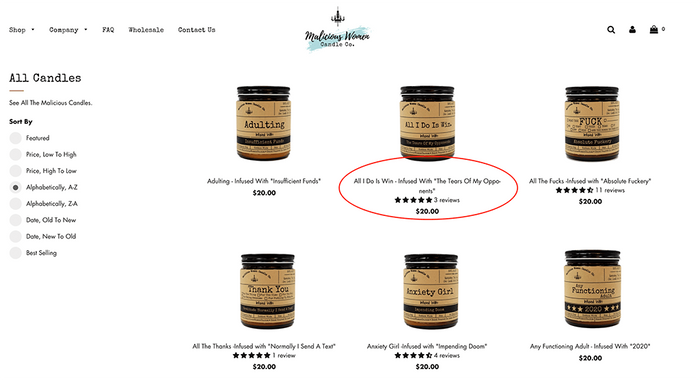
HOW TO WRITE PRODUCT DESCRIPTIONS THAT REALLY SELL.
What are you selling? Why do your customers want it?
Any Shopify store owner should know the answer to these two questions. If you’re targeting your audience correctly, your audience should be able to answer these questions too. That’s why your product descriptions are right at the heart of your online success. After all, this is what customers see right before they buy.
Believe or not there’s an art to compiling the most effective product descriptions – ones that really sell.
We’ll take you through the steps you need to compose the best descriptions and give you some advice for getting personal and creative. This is an in-depth guide to crafting the ultimate product description, but if you’re pushed for time, scroll to the end where we’ve got a run-down of fast Shopify product description hacks.
WHY YOUR PRODUCT DESCRIPTION IS IMPORTANT
A product description is the text and image of an individual product on your site. It’s what appears in Google Shopping, and it’s the block of content that will direct customers to ‘Buy now’ or ‘Add to basket’.
In marketing terms, your product description is at the bottom of ‘The Funnel’. Your potential customers have followed your tempting trail of breadcrumbs to your product, but have not yet converted to a buyer. You may have used a lot of resources to get them to this exact moment – the moment where their finger hovers over the ‘Buy Now’ button.
So, the product description is a final push over the finish line. Get it right and your conversions will skyrocket.
No matter where your buyer has come from, whether that is via social media, targeted ads, landing pages, etc., this is the ‘sale’ point. Your product description is the moment at which your buyer will choose to buy or bounce away – so it has to deliver. Be specific and keep it personal.
TO BUY OR NOT TO BUY
The product description is what will ultimately make your customer buy or bounce.
We’ll be touching on points to help your eCommerce store climb the search engine rankings and optimize your product descriptions, but the key takeaway is always to keep the customer in mind. Write for your customers and success will follow.
Always remember: people respond to people. Keep it natural, personal and customer-centric.
WHAT SHOULD A GOOD PRODUCT DESCRIPTION DELIVER?
For your user, it has to have that magical concoction of enticing copy and practical information. It’s treading the tightrope of including all the details without overwhelming your reader.
A great product description tells a potential buyer exactly what it is without ‘selling’ it.
Getting it right for your customers will also improve your SEO. Product descriptions affect SERP (Search Engine Results Pages) rankings.
THE PERFECT PRODUCT DESCRIPTION RECIPE
The ultimate product description has six main ingredients. Hit all six of these, and you’ll have a recipe for success – and a product description that will boost your store ranking and increase sales.
Six ingredients for success:
- Product name. Not just any old product name; an excellent product name. What makes is ‘excellent’? It needs to describe what it is and hit your SEO.
- Images. Multiple, high-quality images with completed, and relevant, alt text.
- The description. This is where you can get creative. It’s not all lists and specs. This is a chance to keep your brand story going and impress your customers.
- Warranty and returns policy. Your customers need to feel safe in their purchases. Clear, open information on returns and warranties are essential.
- Meta description. How will people find your product? You’ve got to make a map for Google to move up the SERPs.
- Google rich snippets. Let’s face it, eCommerce is a jam-packed marketplace. This little ‘snippet’ will help you to stand out from the crowd.
Before you get started on any product descriptions, it’s a good idea to have some relevant keywords up your sleeve. This will help put your product in front of the right audience and improve your SEO.
KEYWORDS AND WHERE TO PUT THEM
Keywords (long and short) are crucial online, but you need to know where to put them. For impactful and effective product descriptions, keep it simple. Once you’ve located your product keywords, be sure to include one in the headline, one or two in the meta description, one or two in the product description, and one in the alt image text. You can also use one in the url for extra support. Don’t overdo it: that’s the key to keywords.
Place your main keyword:
- In the product name
- Meta description
- Product description
- Image alt text
You can get help with identifying some common keywords to use for your product names with Google Trends.
STEP 1: PRODUCT NAME
Your product name is one of the most important parts of your product description. For many browsers, the name and image will be all they see (especially if you’re plugged into Google Shopping). It’s the basics that will be visible to your broadest pool of potential customers – those at the top of ‘The Funnel’ if you’re using marketing terms.
So, clarity is everything.
It needs to be short and to-the-point, so a good rule of thumb is to write your product name as you would search for it, using the most important yet most generic copy first.
- Start with what it is.
- Include defining or important information, such as size, color, etc.
- Do not use capital letters.
- Avoid adding any promotional words.
- Title case each word.
Your product name should sell without promoting. But it should tell your customer in a heartbeat what it is. Write your product descriptions as if they will be read apart from anything else: no marketing jargon around them, no in-jokes or references, no waffle.
Example: Red Square Neck Bodycon Sleeveless Dress – US 12
Or you may want to lead with your brand name:
Example: Gucci – Buttoned Midi-Dress – Women – Silk/Acetate/Wool – Red
Think about the common words in this case: dress, red, and then the defining characteristics, such as: square neck, bodycon, buttoned, etc. Include sizes and material if there’s room, and include your brand name, should you want to raise brand awareness.
How to be creative with your product name…
All I do is win – infused with ‘the tears of my opponents’.

It’s a great line. Creative and a bit sassy. But as a standalone product name, we don’t know what this is. Combine this product name with an image, and it becomes clearer – we know it comes in a jar. Perhaps it’s a jar of food (with a name like that, it could be protein-packed). We only know that it’s a candle if we come directly to the site Malicious Women Candle Co. And, here we come to how to make creative product names work. To begin with, this brand has one product: candles. The word ‘candle’ is in their brand name. So, if we are shopping their collections, we already in the land of candles. We don’t need ‘candle’ at the beginning of every product, and it gives their team some creative license.
Don’t forget. This works because they’ve chosen clever, creative names for their products. Effectively their product name still leads with the most important thing: the name of the product. Make sense? On their Amazon listing, for example, we can see that their product name is their brand name followed by the name of the candle, with some supporting information: Malicious Women Candle Co., product name, main ingredient, and weight.

If you really want to have more creative product names, think about naming the actual products. What your customer sees online MUST be what they get. Keep it consistent across your site. So, whatever aspects you list, do so in the same order.
STEP 2: IMAGES
We all love looking at pictures. Humans process images 60,000 times faster than simply reading text on a page, and including relevant visuals on a page can improve page views by a whopping 94%. Images and visual content (including videos) help us to understand what a product is and how it will fit into our lives – whether that be into our homes, our workplace, on our body or in the cupboard. So, images are just as important as words in your product description.
Just as you write your product name with clarity and consistency, you should apply the same rules to images. Make sure they are clear, in-focus, and preferably against a white or neutral background. Images should be high quality, but don’t upload enormous files – these will take an age to load on mobile or slower connections, and could cause drop-offs.
THE IMPORTANCE OF ALT TEXT
Image alt text is important for SEO. It’s how Google knows what your product is displaying. The alt text will also show for images that don’t load and is highly useful for those who are visually impaired (this is the text that will read out what images are visible on a site).
So, don’t forget it. It doesn’t have to be lengthy, and can be similar to your product name. Use your keyword, and keep it descriptive yet short.
STEP 3: THE DESCRIPTION
You’ve spent time crafting perfectly concise product names to accompany the right image. Now your product description gives you a little more room for expansion.
Here you want to write a little more around what the product is. You can include more of a brand tone here, but that’s not to say write reams and reams. You still want to keep it concise. Remember your audience are human, and not only that but we see roughly 4,000 adverts a day. That’s not just online; it’s on billboards, on buses, in store windows, on the tote bag of the woman walking ahead of you on the sidewalk. We’re bathed in words from the minute we wake up, to when we close our eyelids on tired eyes at the end of the day.
So, how do you connect with someone using words, in a sea of words? You use power words.
In fact, the most effective eCommerce product descriptions use power words.
POWER WORDS
So, what are ‘power words’ and how do you use them? Power words are persuasive and inspire emotion. They are the words you use to reach out and speak to your audience in a way that causes them to take action.
For example, power words that are price-based and engage ‘immediacy’ are: cheap, affordable, free, bonus, sale, today, exclusive. Or target the other end of the spectrum and inspire exclusivity by using power words such as: glamourous, guilt-free, luxurious and indulgent, to seduce them into clicking ‘add to basket’. To draw attention to a ‘remarkable’ product use words like: unexpected, miracle, new, latest.
Try including different power words in your product descriptions and test to see what creates the best conversions. You can then use that data to craft even more accurate descriptions that you know will speak to your audience. After all, that’s what your descriptions are about and who they are for. We might harp on about it but, really and truly, understanding your audience and being able to respond rapidly to their preferences is the fastest way to create, not just the right product descriptions, but your brand success.
So, keep it engaging and personal. Keep it informative. And keep it short.
STEP 4: WARRANTY AND RETURNS POLICY
Your description should also cover warranty and returns. You don’t have to elaborate, but make sure the relevant links are there. If a customer sees a description where every element of the transaction is transparent and clear, this will build trust. So then you’ve covered any questions, and you’ve built trust with your audience in an instant.
STEP 5: META DESCRIPTION
Your meta description should summarize your product in fewer than 160 characters. Meta descriptions drive click-throughs. Think of them as product pitches. You’ve got to get your buyer’s attention in a sea of blue headlines. They’re short, snappy, to-the-point, and should capture your audience in two ways:
- Engage. Use words that will create an emotional and/ or persuasive connection.
- Inform. Include some of the key details. What is it that they are looking for (the product name) and why they should click on your link over someone else’s.
HOW TO AVOID THE MOST COMMON META DESCRIPTION PITFALLS
- Miss them completely. Some people pay little attention to meta descriptions, and it’s easy to forget about them in a sea of product uploads. But these short lines could boost your product descriptions, improve your SEO, and drive more conversions than you think.
- Copy and paste. It’s not against the rules to copy and paste meta descriptions but your customers will notice, and it creates clunky content for your site. Stay brand savvy and clear by keeping metas unique, even if that means just changing a few words. If you’re really pushed for time and/or resources, at least keep your product categories different.
- Overlook HTML tables. Even if you’ve never given this a go, it’s worth a trial. This helps Google display your information in a table rather than in paragraph form, so it’s great if you want to list a lot of spec, products, categories, etc. Basically anything in a list that would look neater in a table.
- Kill keywords. Your meta description is just the right place for keywords. If you put them anywhere, put them here. This is where Google looks for information first and foremost, so you need it to be spot-on to come up in relevant searches.
- Write like a robot. Include keywords, but don’t write like a bot. In meta descriptions they won’t affect your ranking, so really write for your reader. Keep it informative and engaging, with a natural flow. But don’t waffle. There are only 160 characters here. So, the trick is to write it and read it aloud. If it sounds natural, run with it. If it sounds fake, do a quick re-write. Trust us, it’s worth it.
If this feels overwhelming, there’s a fast hack to writing your product meta descriptions. Check out the competition. We don’t mean copy other people. But to give you an idea of what to include, a quick search into the domain you want to break into, goes a long way…
WHAT ARE YOUR COMPETITORS SAYING?
Do your research. That means looking at what comes up when you search. What words, offers, and service are your competitors using? Perhaps you can clearly see that you have something to offer that is not being met by the top 10 Google rankings. For example, you might have stand-out USPs, such as a better price, free delivery or offers. If there’s a gap, dive right in and include it in your meta.
But, also don’t be afraid to use your competitors for reference. Even if you can’t outbid them on price, if their price is in their meta descriptions, make sure yours is too. If they include location and shipping details and they’re on that first Google page, use that as a template and ensure you have the same information on offer.
WAYS TO SUPPORT YOUR PRODUCT DESCRIPTION
Support your product descriptions with additional information your readers can understand at a glance.
- Images and/or videos
- Reviews
- Star ratings
- 1-step ordering
- Easy payment/checkout process
The best way to get these little extras in and support your eCommerce SEO rankings in Google is to get in rich snippets.
STEP 6: GOOGLE RICH SNIPPETS
So, what’s a rich snippet? Well, a normal snippet is what Google will show you in a list of search results. It’s the standard blue title text, website link and a little ‘snippet’ of information pulled from the content, usually displayed in grey. A rich snippet is a little extra. Adding it to your listing is like a beautifully iced cake in a sea of Victoria sponges. It works to entice and set you apart from the rest.
Like a cake, it adds richness to your product description. There are multiple rich snippets you can add:
- Image/s
- Star ratings
- Videos
- Reviews
- Product name
- Price
- Availability
- Google Shopping
Rich snippets help to optimize your product descriptions. Google constantly looks for data and content to promote to top spots and first pages (the places you want to appear for the most amount of traffic). Google loves pleasing searchers (your potential customers), and rich snippets are a high priority.
Think back to the last time you started typing something into Google. Immediately it begins to ‘pull’ rich snippets, especially if it thinks you’re searching for a product. It’s common to see star ratings, for example, an image or video. It’s more information for your buyer, fast. Helping them to click on your product and send them to the full product description.
PUT A RICH SNIPPET INTO ACTION:
If you have already set up your Shopify store with a theme, check to make sure that the one you’re using has ‘structured data markup’ in the theme description. Only themes with this capability will enable you to create rich snippets.
Google helps you out with your rich snippets. Start by visiting their online tool to test your URLs. Paste your product URL. The page you see next is divided into two. The left-hand side will be lines of code. You want to focus your attention on the right-hand side. At the top are three buttons: Preview, Errors, and Warnings. The grey arrow across the middle is your ‘Validate’ button.
If your URL is a-ok with Google you’ll be presented with a preview, displaying what users see on a search page.
If you do have errors and warnings, get an expert to fix them
Finally…
MAKE IT EASY TO PAY.
As we mentioned above in supporting your product descriptions. The way to make them really pay off is to enable is a super simple, super speedy way to pay. Faster checkouts mean faster conversions.
Read more on how to improve your checkout process.
FAST HACKS FOR BETTER PRODUCT DESCRIPTIONS
Make radical changes in minutes.
#HACK 1 PRODUCT NAME.
Review your product names. What are your customers searching for and does your product name reflect that? Does it describe what it is and include small details that set it apart? Don’t just write a product name, write an excellent, specific product name that tells not sells (so, no offers or sales pitches). Keep it clear and consistent.
#HACK 2 IMAGES.
Include multiple, high-quality images with completed and relevant alt text. Like your product name, clarity and consistency are key. High-quality doesn’t mean high MB. Don’t impact load time with giant files.
#HACK 3 THE DESCRIPTION.
Get creative. It’s not all lists and specs. This is a chance to keep your brand story going and impress your customers. Include more details, such as product sizes, weight, care, colors etc. but make it readable. Your customers may skim read this part, or they may linger and deliberate. Write for both.
#HACK 4 WARRANTY AND RETURNS POLICY.
Make sure your customers feel safe in their purchases. Clear, open information on returns and warranties are essential.
#HACK 5 META DESCRIPTION.
How will people find your product? Don’t make the mistake of missing this step. Include your SEO keyword and a concise yet thorough description. It’s a map of words to help Google find your product and put it in front of the right person (or collection of search words).
#HACK 6 GOOGLE RICH SNIPPETS.
In a crowded eCommerce marketplace, any additional tricks will help. Utilize rich snippets to stand out apart from your competitors.
Target all hacks to improve your product description game, or just change up a few.
-

Using MindBody Branded Web Widgets with React
-

7 key elements for Shopify store growth in 2020
-

10 Google shopping ads Strategies to up Your Game in 2020
-

HOW TO BUILD A KILLER PRODUCT COLLECTION ON SHOPIFY
-

HOW TO BE A SHOPIFY SHIPPING EXPERT
-

HOW TO CREATE PRODUCT IMAGES THAT REALLY CONVERT
-

HOW TO SET UP AN ONLINE SHOP ON THE FLY
-

HOW TO UX-OPTIMIZE YOUR SITE
-

POWERFUL PRODUCT PAGES THAT REALLY SELL
-

HOW TO GET QUALITY CUSTOMER REVIEWS
-

HOW TO CREATE A HYPERLOCAL MARKETING CAMPAIGN
-

HOW TO SEO OPTIMIZE YOUR ECOMMERCE STORE
-

HOW TO USE GOOGLE SMART SHOPPING
-

7 WAYS TO SPEED UP A MAGENTO SITE
-

HOW TO KEEP CUSTOMERS LOYAL

Get updates & stay connected with Orange Collar
1630 Welton St. #940Denver, CO 80202
1630 Welton St. #940Denver, CO 80202